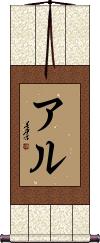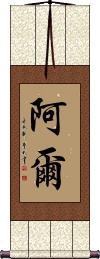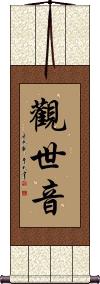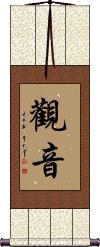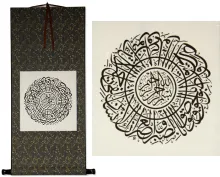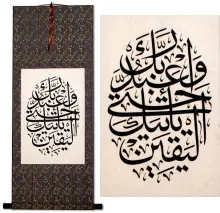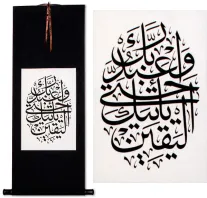Many custom options...
And formats...

Al in Chinese / Japanese...
Buy an Al calligraphy wall scroll here!
Personalize your custom “Al” project by clicking the button next to your favorite “Al” title below...
Goddess of Mercy and Compassion
This is the long or more formal version of this title
觀世音 is the longer and perhaps more formal title for the Buddhist deity known as the Goddess of Mercy or Bodhisattva of Compassion.
The longer title of this bodhisattva is Romanized in the following ways:
Mandarin Chinese: Guanshi Yin, Kuan-shih Yin.
Japanese: Kanzeon.
Sanskrit: Bodhisattva Avalokitesvara.
Korean: Gwan-se-eum.
Vietnamese: Quan Thế Âm.
Thai: Prah Mae Kuan Eim.
English: Bodhisattva of Mercy and Salvation, Goddess of Compassion, Buddha of Mercy, et al.
Please view our more common and shorter version, “Guan Yin” before you make a decision. Also, note that the first character has a slight variation in Japanese. If your audience is specifically Japanese, you may want to select that version.
Goddess of Mercy and Compassion
觀音/観音 is the Buddhist deity known as the Goddess of Mercy or Bodhisattva of Compassion.
In Chinese, the proper name of this being is Guan Yin. There is some debate as to whether Guan Yin is female. The argument comes from some scripture that suggests Buddhist deities take on the male form. Others say that Guan Yin has no sex. And still, others are okay with the female representation of Guan Yin.
This bodhisattva is also known or Romanized in the following ways:
Mandarin Chinese: Guan Yin, Kuan Yin, Kwan Yin.
Japanese: Kannon, Kwannon.
Sanskrit: Bodhisattva Avalokitesvara.
Korean: Gwan-eum.
Vietnamese: Quan Âm.
Thai: Kuan Eim.
English: Bodhisattva of Mercy and Salvation, Goddess of Compassion, Buddha of Mercy, et al.
Note: The first character has a slight variation in Japanese. If your audience is specifically Japanese, you may want to select that version.
See Also: Buddhism | Goddess | Namo Amitabha | Bodhisattva
This in-stock artwork might be what you are looking for, and ships right away...
Gallery Price: $85.00
Your Price: $46.88
Not the results for Al that you were looking for?
Below are some entries from our dictionary that may match your Al search...
| Characters If shown, 2nd row is Simp. Chinese |
Pronunciation Romanization |
Simple Dictionary Definition |
か see styles |
ka か |
(particle) (1) (at sentence end) indicates a question; (particle) (2) (after each alternative) or; whether or not; (particle) (3) (after an interrogative) (See 何か・1) some- (e.g. something, someone); (particle) (4) (indicates doubt, uncertainty, etc.; sometimes after other particles) hmm; huh; (prefix) (5) (emphatic prefix; usu. before an adjective) (See か弱い) very; (suffix) (6) (suffix forming adjectives or adverbs; after an indeclinable word) (See 定か) -al; -ial; -ic; -ical; -ish; -y; (adverb) (7) (archaism) in that way |
アル see styles |
aru アル |
More info & calligraphy: Al |
華金 see styles |
hanakin はなきん |
More info & calligraphy: Joaquin |
阿明 see styles |
ā míng a1 ming2 a ming |
More info & calligraphy: Armin |
ハサブ see styles |
hasabu ハサブ |
More info & calligraphy: Hassab |
侯賽因 侯赛因 see styles |
hóu sài yīn hou2 sai4 yin1 hou sai yin |
More info & calligraphy: Hussein |
曼蘇爾 曼苏尔 see styles |
màn sū ěr man4 su1 er3 man su erh |
More info & calligraphy: Mansur |
ズハイル see styles |
zubairu ズバイル |
(place-name) Al Zubayr; Zubair |
有 see styles |
yǒu you3 yu yumi ゆみ |
to have; there is; (bound form) having; with; -ful; -ed; -al (as in 有意[you3yi4] intentional) (1) existence; (n,n-pref) (2) possession; having; (3) (abbreviation) (in company names; written as (有)) (See 有限会社) limited company; (personal name) Yumi bhāva: that which exists, the existing, existence; to have, possess, be. It is defined as (1) the opposite of 無 wu and 空 kong the non-existent; (2) one of the twelve nidānas, existence; the condition which, considered as cause, produces effect; (3) effect, the consequence of cause; (4) anything that can be relied upon in the visible or invisible realm. It means any state which lies between birth and death, or beginning and end. There are numerous categories— 3, 4, 7, 9, 18, 25, and 29. The 三有 are the 三界 trailokya, i. e. 欲, 色 and 無色界 the realms of desire, of form, and of non-form, all of them realms of mortality; another three are 本有 the present body and mind, or existence, 當有 the future ditto, 中有 the intermediate ditto. Other definitions give the different forms or modes of existence. |
等 see styles |
děng deng3 teng hitoshi ひとし |
to wait for; to await; by the time; when; till; and so on; etc.; et al.; (bound form) class; rank; grade; (bound form) equal to; same as; (used to end an enumeration); (literary) (plural suffix attached to a personal pronoun or noun) (suffix) (1) (kana only) pluralizing suffix; (suffix) (2) (kana only) (See あちら,いくら・1) or so; rough indicator of direction, location, amount, etc.; (suffix) (3) (kana only) (after the stem of an adjective) (See 清ら) nominalizing suffix; (s,m,f) Hitoshi To pair; parallel, equal, of like order; a class, grade, rank; common; to wait; sign of plural. In Buddhist writings it is also used for 'equal everywhere', 'equally everywhere', 'universal'. |
Q彈 Q弹 see styles |
q tán q tan2 q t`an q tan |
(of a food's mouthfeel) springy; firm; al dente |
きさ see styles |
giza ギザ |
(place-name) Al-Jizah (Egypt); Giza (Egypt) |
彈牙 弹牙 see styles |
tán yá tan2 ya2 t`an ya tan ya |
al dente |
戈爾 戈尔 see styles |
gē ěr ge1 er3 ko erh |
Gore (name); Al Gore (1948-), US vice-president 1993-2001 under Bill Clinton, subsequently environmental campaigner and Nobel Peace laureate |
拉登 see styles |
lā dēng la1 deng1 la teng |
(Osama) bin Laden (1957-2011), leader of Al Qaeda |
文殊 see styles |
wén shū wen2 shu1 wen shu monju もんじゅ |
Manjushri, the Bodhisattva of keen awareness (Buddhist term) Manjushri; Manjusri; Bodhisattva that represents transcendent wisdom; (p,s,f) Monju (文殊師利) Mañjuśrī 滿殊尸利 -later 曼殊室利. 文殊 is also used for Mañjunātha, Mañjudeva, Mañjughoṣa, Mañjuṣvara, et al. T., hjamdpal; J., Monju. Origin unknown; presumably, like most Buddhas and bodhisattvas, an idealization of a particular quality, in his case of Wisdom. Mañju is beautiful, Śrī; good fortune, virtue, majesty, lord, an epithet of a god. Six definitions are obtained from various scriptures: 妙首 (or 頭 ) wonderful or beautiful) head; 普首 universal head; 濡首 glossy head (probably a transliteration); 敬首 revered head; 妙德 wonderful virtue (or power); 妙吉祥 wonderfully auspicious; the last is a later translation in the 西域記. As guardian of wisdom 智慧 he is often placed on Śākyamuni's left, with 普顯 on the right as guardian of law 理, the latter holding the Law, the former the wisdom or exposition of it; formerly they held the reverse positions. He is often represented with five curls or waves to his hair indicating the 五智 q. v. or the five peaks; his hand holds the sword of wisdom and he sits on a lion emblematic of its stern majesty: but he has other forms. He is represented as a youth, i. e. eternal youth. His present abode is given as east of the universe, known as 淸涼山 clear and cool mountain, or a region 寶住 precious abode, or Abode of Treasures, or 寶氏 from which he derives one of his titles, 寶相如來. One of his dhāraṇīs prophesies China as his post-nirvāṇa realm. In past incarnations he is described as being the parent of many Buddhas and as having assisted the Buddha into existence; his title was 龍種上佛 the supreme Buddha of the nāgas, also 大身佛 or 神仙佛; now his title is 歡喜藏摩尼寶精佛 The spiritual Buddha who joyfully cares for the jewel: and his future title is to be 普現佛 Buddha universally revealed. In the 序品 Introductory Chapter of the Lotus Sutra he is also described as the ninth predecessor or Buddha-ancestor of Śākyamuni. He is looked on as the chief of the Bodhisattvas and represents them, as the chief disciple of the Buddha, or as his son 法王子. Hīnayāna counts Śāriputra as the wisest of the disciples, Mahāyāna gives Mañjuśrī the chief place, hence he is also styled 覺母 mother, or begetter of understanding. He is shown riding on either a lion or a peacock, or sitting on a white lotus; often he holds a book, emblem of wisdom, or a blue lotus; in certain rooms of a monastery he is shown as a monk; and he appears in military array as defender of the faith. His signs, magic words, and so on, are found in various sutras. His most famous centre in China is Wu-tai shan in Shansi. where he is the object of pilgrimages, especially of Mongols. The legends about him are many. He takes the place in Buddhism of Viśvakarman as Vulcan, or architect, of the universe. He is one of the eight Dhyāni-bodhisattvas, and sometimes has the image of Akṣobhya in his crown. He was mentioned in China as early as the fourth century and in the Lotus Sutra he frequently appears, especially as the converter of the daughter of the Dragon-king of the Ocean. He has five messengers 五使者 and eight youths 八童子 attending on him. His hall in the Garbhadhātu maṇḍala is the seventh, in which his group numbers twenty-five. His position is northeast. There are numerous sutras and other works with his name as title, e. g. 文殊師利問菩提經 Gayaśīrṣa sūtra, tr. by Kumārajīva 384-417: and its 論 or .Tīkā of Vasubandhu, tr. by Bodhiruci 535. see list in B. N. |
經笥 经笥 see styles |
jīng sì jing1 si4 ching ssu kyōshi |
A case for the scriptures, bookcase or box, also 經箱 et al. |
經部 经部 see styles |
jīng bù jing1 bu4 ching pu kyōbu |
(經量部) Sautrantika, an important Hīnayāna school, which based its doctrine on the sūtras alone, cf. Keith, 151 et al. |
花金 see styles |
hanakin はなきん |
thank God it's Friday; TGIF; going out on Friday night; flowery Friday (when young men et al. stay out late); (surname) Hanakin |
露天 see styles |
lù tiān lu4 tian1 lu t`ien lu tien roten ろてん |
outdoors; al fresco; in the open (noun - becomes adjective with の) open air |
類篇 类篇 see styles |
lèi piān lei4 pian1 lei p`ien lei pien |
Leipian, Chinese character dictionary with 31,319 entries, compiled by Sima Guang 司馬光|司马光[Si1 ma3 Guang1] et al in 11th century |
あかは see styles |
akaba アカバ |
(place-name) Al-Aqabah; Aqaba |
ウラー see styles |
uraa / ura ウラー |
(interjection) hooray (rus: ura); hurrah; (place-name) Al-Ula (Saudi Arabia); Ulla |
カラク see styles |
karaku カラク |
(place-name) Al-Karak (Jordan); Calah; Kalach; Kalak |
クルナ see styles |
kuruna クルナ |
(place-name) Al Qurnah (Iraq); Al-Qurnah (Iraq); El Qurna (Arab Union); Khulna (Bangladesh) |
ザルカ see styles |
zaruka ザルカ |
(place-name) Al-Zarqa (Jordan); Zarca |
ハイー see styles |
haii / hai ハイー |
(place-name) Al Hayy |
ハサカ see styles |
hasaka ハサカ |
(place-name) Al-Hasakah (Syria) |
ばちん see styles |
bachin バチン |
(adverb taking the "to" particle) (1) (onomatopoeic or mimetic word) (with a) slap; smack; whack; sound of a sharp blow with something flat; (2) (onomatopoeic or mimetic word) wham; sound of striking with something solid; (3) (onomatopoeic or mimetic word) zap; crack; sound of thunder; (place-name) Al Batin (Saudi Arabia) |
ハナ金 see styles |
hanakin ハナきん |
thank God it's Friday; TGIF; going out on Friday night; flowery Friday (when young men et al. stay out late) |
Click here for more Al results from our dictionary
The following table may be helpful for those studying Chinese or Japanese...
| Title | Characters | Romaji (Romanized Japanese) | Various forms of Romanized Chinese | |
| Al | アル | aru | ||
| Al | 阿爾 阿尔 | ā ěr / a1 er3 / a er / aer | a erh / aerh | |
| Goddess of Mercy and Compassion | 觀世音 观世音 | guān shì yīn guan1 shi4 yin1 guan shi yin guanshiyin | kuan shih yin kuanshihyin |
|
| Goddess of Mercy and Compassion | 觀音 / 観音 观音 | kan non / kannon | guān yīn / guan1 yin1 / guan yin / guanyin | kuan yin / kuanyin |
| In some entries above you will see that characters have different versions above and below a line. In these cases, the characters above the line are Traditional Chinese, while the ones below are Simplified Chinese. | ||||
Successful Chinese Character and Japanese Kanji calligraphy searches within the last few hours...
